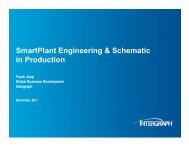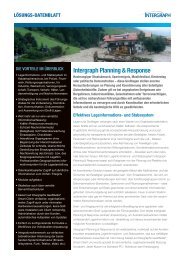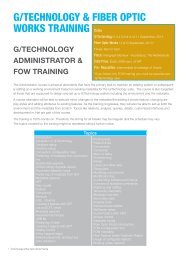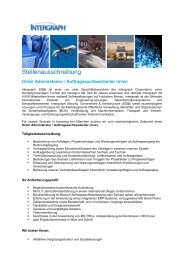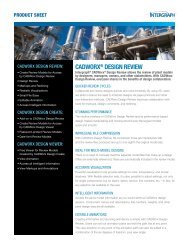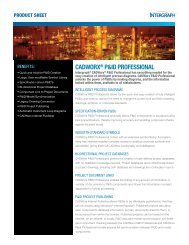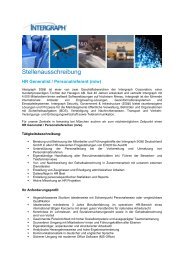Read the Nuclear Industry Spotlight - Intergraph
Read the Nuclear Industry Spotlight - Intergraph
Read the Nuclear Industry Spotlight - Intergraph
You also want an ePaper? Increase the reach of your titles
YUMPU automatically turns print PDFs into web optimized ePapers that Google loves.
SECTION TITLE GOES HERE<br />
Case study: PBMR<br />
Bringing It All Toge<strong>the</strong>r<br />
PBMR takes advantage of data integration to speed construction of next-generation<br />
nuclear plants<br />
n By Pat Thomson<br />
In 1994, two events of global significance occurred<br />
in South Africa. The first was <strong>the</strong> successful completion<br />
of <strong>the</strong> country’s first democratic election. The<br />
second was <strong>the</strong> project development launch of <strong>the</strong><br />
Pebble Bed Modular <strong>Nuclear</strong> Reactor (PBMR) by<br />
Eskom, one of <strong>the</strong> top 10 utilities in <strong>the</strong> world. The<br />
South Africa power utility giant had concluded that<br />
PBMR technology showed considerable technical<br />
and commercial merit for future energy demands<br />
in South Africa, as well as throughout <strong>the</strong> world.<br />
In 1999, Eskom joined with <strong>the</strong> Industrial<br />
Development Corporation of South Africa (IDC),<br />
British <strong>Nuclear</strong> Fuels and <strong>the</strong> U.S. utility Exelon<br />
to create PBMR (Pty) Ltd. to build and market<br />
PBMR-based power plants. (Later, Exelon withdrew<br />
from PBMR to focus on its core business<br />
of power generation plant operations and power<br />
sales brokerage.) The new company completed a<br />
feasibility study which showed <strong>the</strong> PBMR technology<br />
was viable and that pebble bed modular<br />
reactors represented one of <strong>the</strong> most viable and<br />
cost-effective means for increasing South Africa’s<br />
power generation.<br />
Consistent power supply<br />
“The beauty of <strong>the</strong> PBMR technology is that it has<br />
intrinsically safe features. It cannot suffer a meltdown,”<br />
said Juan le Roex, power plant division<br />
software systems manager for PBMR. “The nuclear<br />
plant is easy to operate and you can regulate<br />
<strong>the</strong> power output. You couldn’t do that with <strong>the</strong><br />
conventional reactors, which needed to run at 100<br />
percent all <strong>the</strong> time. Also, <strong>the</strong> pebble bed design<br />
allows us to refuel <strong>the</strong> plant without shutting it<br />
down, which represents enormous cost savings.<br />
For example, Koeberg, <strong>the</strong> nuclear plant near Cape<br />
Town, has to be shut down for about 100 days<br />
each 18 months for refueling purposes.”<br />
It is already evident that South Africa has to add<br />
electricity generation capacity since <strong>the</strong> country’s<br />
peak demand is starting to exceed capacity,<br />
especially during peak hours. Today, almost 90<br />
percent of <strong>the</strong> country’s electricity is generated<br />
by coal-fired power stations, with <strong>the</strong> Koeberg<br />
nuclear plant providing an additional five percent<br />
of <strong>the</strong> country’s needs. The remaining five percent<br />
is generated by hydroelectric and pumped storage<br />
means. PBMR’s feasibility study demonstrated<br />
that <strong>the</strong>re are few, if any, new hydroelectric sites<br />
in South Africa that could be developed to deliver<br />
significant amounts of power, and <strong>the</strong> country’s<br />
natural gas resources are too limited to qualify as<br />
a viable power generation option.<br />
Moving forward, Eskom wants to reduce <strong>the</strong> country’s<br />
dependence on coal from 90 to 70 percent of<br />
supply. In 2005, South Africa declared <strong>the</strong> PBMR<br />
project a National Strategic Project, demonstrating<br />
<strong>the</strong> importance of <strong>the</strong> PBMR development to<br />
South Africa’s future.<br />
Unifying disciplines<br />
PBMR executives strongly believe <strong>the</strong> pebble bed<br />
technology will be of great benefit to countries<br />
around <strong>the</strong> world, so <strong>the</strong> company is working<br />
to design and build a demonstration plant at<br />
10 Insight<br />
Insight: Special Focus




